
Text © Giuseppe Mazza

English translation by Mario Beltramini
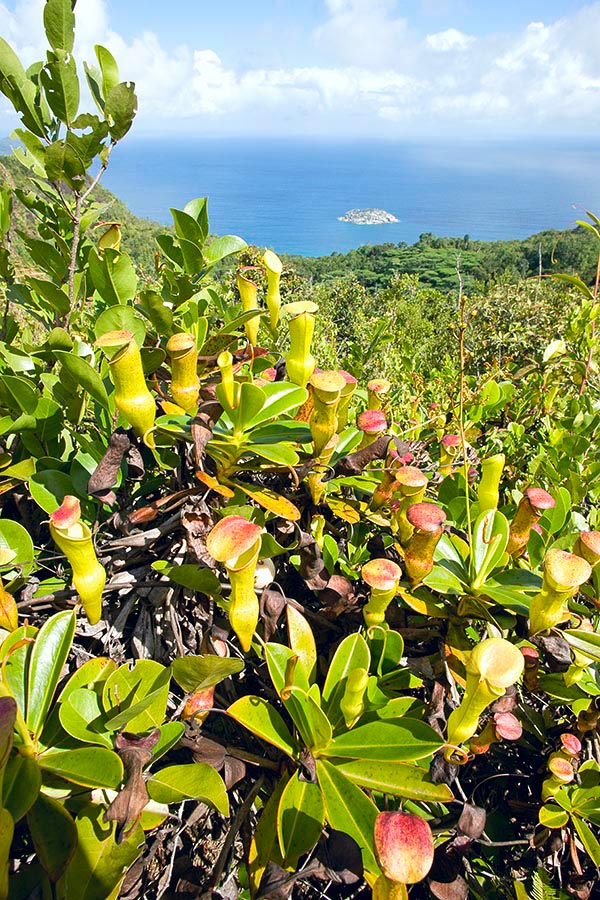
Nepenthes pervillei is endemic to Mahé and Silhouette Islands (Seychelles) between 450-750 m of altitude © Giuseppe Mazza
Jean-Claude Nicette, of the Seychelles Tourism Board, shows us a footpath hidden by the bush.
We are in the island of Mahé, Seychelles, and he takes us, as he has already done other times with journalists, in a secret area, where carnivorous plants grow up, luxuriant and happy, sheltered from tourists.
Big granite rocks, which decompose in a quartz ground, and the remains of an old plantation of cinnamon.
We pay attention not to stumble on the roots which come to the surface, and I think how much we are lucky to be able to walk here, at the equator, absolutely safe, as in the garden of our house.
No poisonous snakes, no ticks, and no malaria.
Even if it may seem incredible, for a person who has been all the day long on the ground, in touch with nature, in two weeks, I have seen only three mosquito, and the tap water is almost always drinkable.
As he had told me, joking while we were at table, Maurice Loustau-Lalanne, president of the Seychelles Islands Foundation, here “the only real danger in Seychelles are women”.
A glance to my wife, Giusy, with whom i share the weights of the photographic equipments, and after a short ascension, we find ourselves in front of a shrub completely covered by the ascidia of a Nepenthes pervillei.
Many small, coloured, carafes, which seem to be laughing under their funny hats.
“It’s the best place for photos”, Jean-Claude says.
The scenery is splendid. The ocean, with a stormy sky, as painters like to represent, and, in front, the small island of the cows.
The problem is that we are in a slope of land.
Between us and the shrub, there is a hole, hidden by the grass. And, even if I would succeed in going down, then I would be lower than the ascidia. In order to photograph them from a height with the panorama, I would need a double ladder, but this is not the case, and so we have to get satisfied with a nice close-up with the telephoto-lens.
“This is the best station”, tells us Jean-Claude, and, he is right indeed. Even if I am somewhat disturbed because of the view , “nice and impossible”, here the plants are really wonderful, with urns double sized if compared to the lean specimen of Copolia, often strangled by the grass and transformed in bonsai by the hunger.
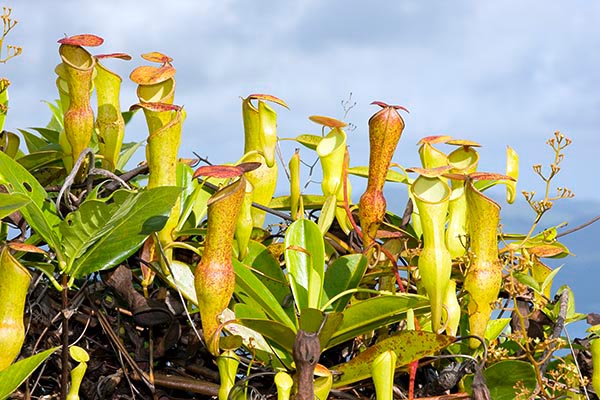
It shows primitive characters and it seems that the cradle of the Nepenthaceae family was rightly here, in this Gondwana area, and that from these lands then have moved eastwards conquering the world © Giuseppe Mazza
I descend the slides, and look around. I go back to the path. It’s sufficient to do a few steps, and my splendid Nephentes, which here are called “Pitcher plant”, “Liane pot à eau”, or sipmly, “Pot à eau”, suddenly disappear.
Even if now, in the whole, the weather is good, already a few drops of rain have fallen, so that we have been obliged to run to protect the lenses, and it could rain suddenly.
In order not to meet any risk, we leave the easel and the bags to Jean-Claude, and we resume walking, lighter, along the path, for the exploration, with only one camera.
After a few minutes of walk, I discover, on my right, on the ground, a showy specimen, with huge ascidia.
And on my left, getting out from the path, an unimaginable extent of Pitcher plant, which have colonized tens of shrubs. I ask my wife to run to recover Jean-Claude, with the rest of the equipment, and I begin to shoot close-ups.
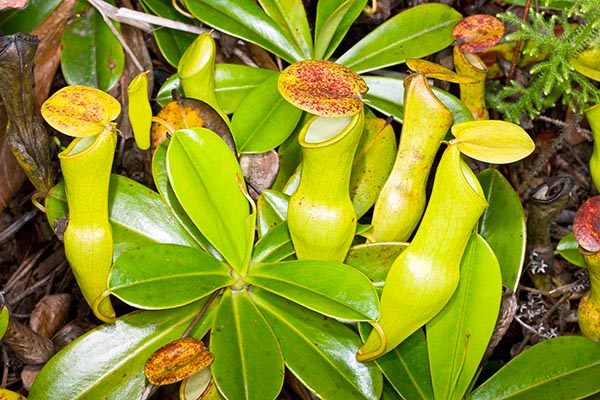
Nepenthes pervillei is a dioecious species, that is with separate male and female ones © Giuseppe Mazza
While ascending, the small roses of the Pitcher plant, become so numerous on the ground, that I do not know where to put my feet, not to stamp upon them.
“Pay attention to the plants”, I shout Giusy from the summit, as she in the meantime has arrived with the supports.
I assemble the wide-angle for a spectacular panoramic sight, I put in bubble, but in the meantime, the sun has disappeared.
We take advantage of the stop, to pull away the weeds which spoil the view on Boileau Bay and the Pointe Lazare of Mahé, and, at last, the perseverance is recompensed.
Later on, a well-known local botanist, Mr. Lindsay Chong-Seng, will explain me everything about these plants.
About 70 species of Nepenthes do exist in the world.
One in Seychelles, two in Madagascar, one in Sri Lanka, and the others between north east of India and China, up to New Caledonia and the north of Australia, with the maximum concentration in Malaysia.
The Nepenthes pervillei grows up only in the islands of Mahé and Silhouette, between 400 and 750 metres of altitude, and seen that it shows primitive characters compared to the other species, it is believed that the birthplace of the Nepenthaceae has been rightly here, in the ancient Gondwana, and that, later, they have moved from these lands eastwards to conquer the world.
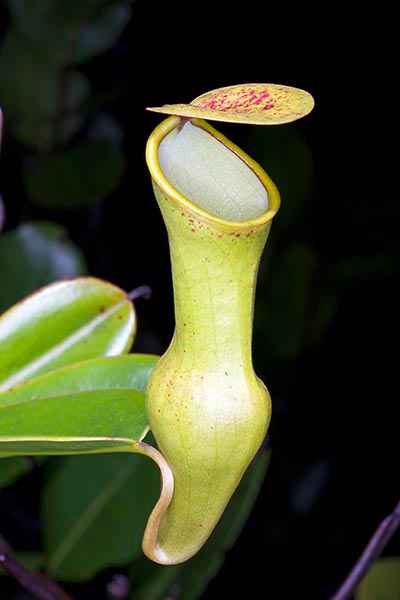
Typical ascidium on a shrub. This “well trap” emits a smell attracting insects. They slide down and cannot come up any more due to the particular inner hairiness bent downwards © Giuseppe Mazza
And there are botanists, who, basing themselves on some specificities of the fruits and the seeds, would like to create a new gender, and talk, quite sure, of an Anurosperma pervillei.
This, while others retort that the differences, yes, they do exist, but that some can found, at intervals, also in other Pitcher plants.
However that may be, they are always dioecius species, that is, with sexes carried by different plants.
And the first group we have found, the one which was suddenly finishing, was probably an “isolated male”, which had colonized tens of metres with its branches.
The Nepenthes pervillei, grow up, in fact, in a very particular manner, unusual, to say the least.
Delicate small plants, with eight mm. leaves, come out from the seeds, and already fabricate very small ascidia, measuring 2 mm. and a half.
They develop with the time. And, after several years, we find on the ground showy “small roses mothers”, with leaves long more than a span, and wide even 7 cm.
The urns grow up at their apex, carried by long, crawling peduncles, which can reach 40 cm.
The strange thing, is that when these small “carafes traps”, grow up in the shade, on the young plants on the soil, they are red purple, with two very large longitudinal, membranous, long brows crests.
Whilst, when they grow up under the full sun, on the branches of the host plant, they do not carry neither crests, nor brows, and peduncles reduce to only 2 to 5 cm., what is enough to keep the ascidia in vertical position, compared to the leaf.
Also, colours change. Rather hairy and rusty at the first stage of growth, they quickly become hairless with green yellowish tonalities, and finally, when old, after some years, get purple stains.
In both cases, they can reach 14 cm. of length, with a cover, more or less red, of about 3 cm. of diameter. It serves to avoid that rainy water does dilute too much the gastric juices, which gather at the bottom of the ascidia.
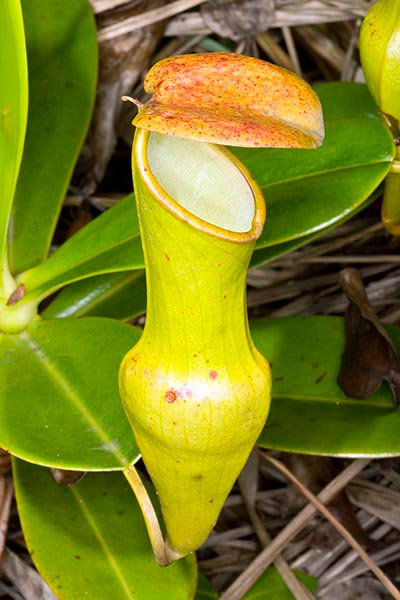
The cover serves to keep out too much water that would dilute the enzymes needed by this carnivorous plant to digest the insects © Giuseppe Mazza
A sticky and mawkish liquid, secreted by the innumerable circular glands which cover the lower part of the inner side.
Over the sides of the trap, they are, on the contrary, perfectly smooth, being covered of waxy cells turned towards the bottom.
When the ill-fated insects, attracted by the scent, slip inside the well, they do not have the least grasp for getting out.
They die for drowning. Their tissues are slowly digested by the proteolytic enzymes of the plant, and at the end, on the bottom of the urn, we can find only the poor chitinous carcasses.
80% of the victims are ants, even if I have seen and photographed several flies on the flowers and on the border of the ascidia.
But let’s go back to the small roses grown on the soil.
After about ten years, they develop a liana, which creeps on the soil till when a bush is met.
It carries apparently similar, but different, leaves, because instead of the ascidia on the extremities, there are usually solid tendrils with which it sticks to the host.
As it is also necessary to eat, every approximately 5 leaves, this liana stops a moment to think about, and then generates a new small rose with ascidia… from which a new liana will set out.
Climb here, grow up to the right, grow up to the left, and down, at the end we discover that a large extent of Nepenthes pervillei is originated eventually by only 3 or 4 mother plants, and that, therefore, it’s a vulnerable species, so much, that it has been included , like the → GIANT TURTLES OF SEYCHELLES, in the Annex II of CITES.
Unlike, for instance, the stolons of the strawberry, the small roses of this plant, in fact, do not generate roots, and when the foot of the plant dies, the whole net is compromised.
Contrary of what, at sight, we might think, seen them in this way, with their innumerable traps stretched out, the Nepenthes pervillei, are not, like the epiphytes, disengaged from the ground, but need deep roots, which pump, incessantly, water and food.
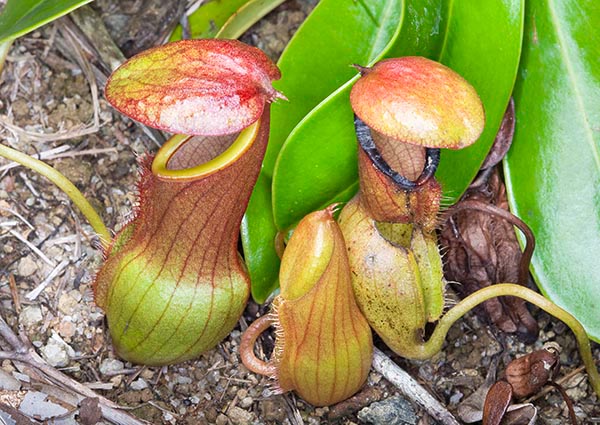
The plants born from seed have long leaves with tendrils. Initially they are tiny and creep with a liana on the ground looking for a guest. Each five leaves they create for nourishing bigger and bigger traps. In the shade the ascidia grow purple red with two showy membranous and ciliate longitudinal crests © G. Mazza
Like all respectable plants, also these fanciful lianas work in fact, every day, under the sun, at full rhythm.
They take the minerals from the ground, and transform them, by photosynthesis, in wood and leaves.
The food which comes with the insects, is for them only a “surplus”, an alimentary peripheral integration, for architectural luxuries and the development of the inflorescences.
When the time of reproduction has come, the male plants generate floral red-brownish ramps of 20-40 cm., which ramify into 10-20 scorpioid tops, that is, disposed, as botanists say, like the tail rolled up of a scorpion.
As you can see from the enlargement on this side, they carry, one close to the other, little starry flowers, which do not measure more than half a cm. Four or five greenish tepals, similar to sharp petals, which protect the stamens, with the anthers close each other on the centre, almost forming a lace.
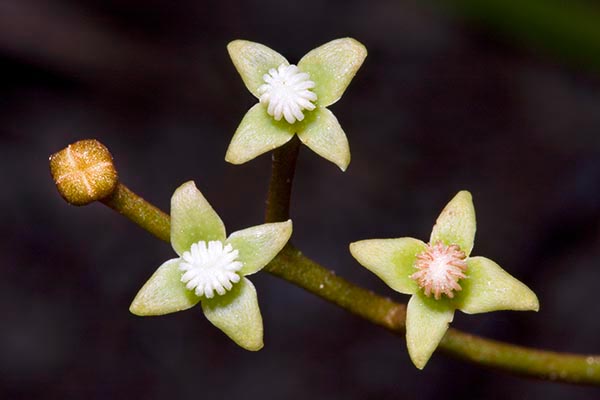
Detail of the tiny male flowers © Giuseppe Mazza
Female plants have similar structures, but less ramified, as it can be seen down below, in the last photo of the service.
The small flowers, with 3-4 short tepals, united at the basis, are, also here, reduced to the minimum. But, rather than starry, they look, in the whole, roundish.
The overy, measures about a couple of millimetres, and is practically hairless.
On the top, 3-4 stigmas, to collect the pollen carried by the insects, and, in section, a hospitable small room with 3-4 loggias, and as many placentae, with the ova waiting for the marriage.
The fruit is an elongated capsule, of 1 and a half cm., which opens with 3 valves to disperse in the wind small spindle-shaped seeds.
Whoever has the chance to go to the Seychelles, can admire these incredible plants in Mahé, at the places called Mont Jasmin, Glacis Sarcelels, Mont Coton, Congo Rouge, Morne Blanc, Trois Frères, Sans Souci, Copolia, Mont Sebert and Broulée.
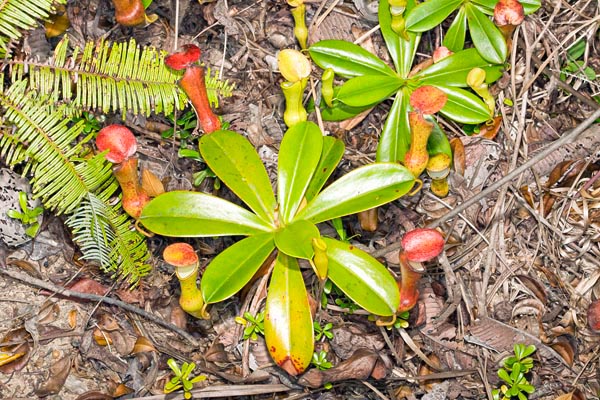
Rosette after rosette, the liana colonizes tens of metres, like a spider-web © Giuseppe Mazza
And at Silouette, they are found on the Grand Congoman, a summit, at a height of 621 metres, which dominates La Passé, or Mont Pot à Eau, name quite clear, for a nice ridge high about 730 metres, east of Mont Dauban, and on the top of the Gratte Fesse.
It goes without saying, that great care must be taken in not walking over them, and that they cannot be picked up.
And, however, it would be a nonsense, because of the growth which is very slow, and of the geo-climatic conditions needed, they are practically impossible to be reproduced.
Even if it may seem impossible, they have discovered, recently that two species of mites and one mosquito, do breed into the ascidia of the Nepenthes pervillei.
Not only they are not digested by the liquid, but they even lay there their eggs.
A sort of symbiosis, then. The animal finds a safe place where to generate the offspring and the plant, however, gets nourishment from their waste.
Something like what happens at sea, with the stinging anemones, feared by all fishes, but the Amphiprion, the charming sea clowns, which build their houses between their deadly tentacles.
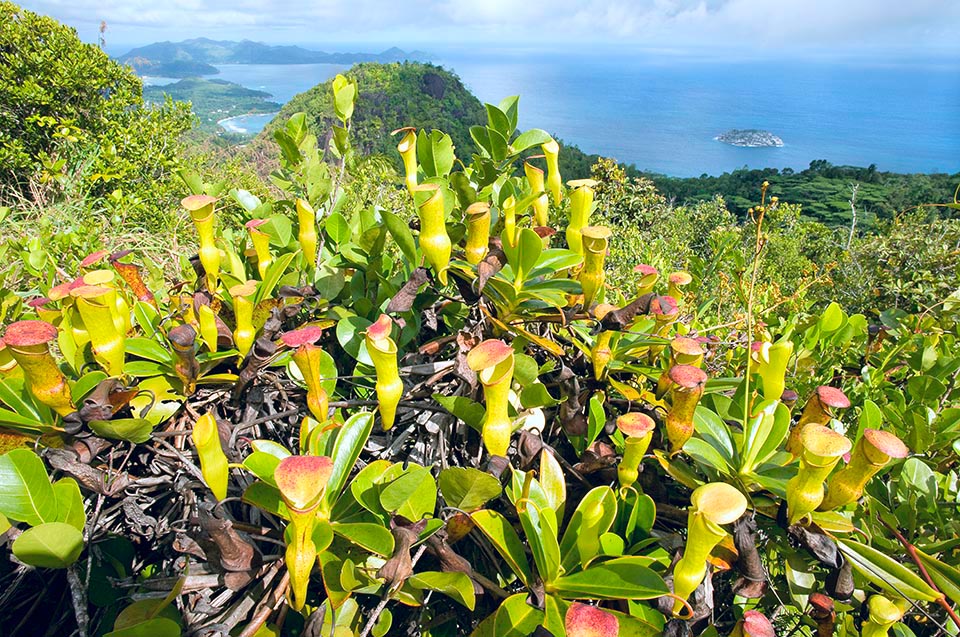
Panorama of Mahé, Seychelles, one of the main stations of Nepenthes pervillei. The female plants, like this, are less ramified © Giuseppe Mazza
